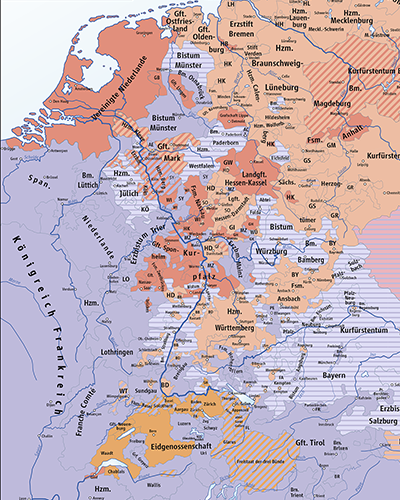 The
Reformed Tradition Spreads
The
Reformed Tradition Spreads
This map indicates the territorial extent of the Calvinist and Zwinglian confessions in the Empire during the second half of the sixteenth century. At mid-century, in 1555, the Reformed tradition seemed to be in full retreat against expansion of Lutheran churches, especially in the larger territorial states of the northern Germany, as well as the Duchy of Württemberg in the southwest. Except for East Frisia in the far northwest and a few refugee churches in the Rhineland, little remained of the initially quite strong southern Reformation. Within a few decades, the influence of Jean Calvin and Geneva altered this situation dramatically. Within the Empire, a number of principalities and city-states established a Reformed brand of Protestantism as the official religion, among them the counties of Bentheim-Tecklenburg (1587), and Lippe (1563-1613) in the north German plain; the Duchy of Anhalt (1590-1596) in the East; the Landgraviate of Hessen-Kassel (1603) and the Palatine Electorate in central Germany; several small counties in the Nassau region; and the cities of Colmar (1575), Bremen (1577), and Emden (1595). In the Rhineland, scattered congregations coalesced into a regional synod (1610-1611). In the powerful northern Electorate of Brandenburg, finally, Reformed Protestantism became the confession of the ruling house of Hohenzollern in 1613, although the vast majority of the population remained Lutheran.
Outside the Empire, Reformed congregations proliferated rapidly in France after 1555: by 1570, fully 1,240 churches were established, most of them within the relatively short period between 1559 and 1562. By 1559, at least seven Reformed churches had been founded in Scotland as well; a series of resolutions by Parliament established a Reformed Church of Scotland during the early 1560s. Protestant worship had been established in nearly all Scottish parishes by 1567. In the Netherlands, Reformed Protestantism spread rapidly in during the "Wonderyear" of 1566. In England, finally, Calvinist doctrines were implanted as the confession of the realm during the last two years of Edward VI's reign (1547-1553), although the short-lived Catholic restoration under Mary (1553-1558) had the effect of terminating any progress toward an English church organized along Calvinist lines.